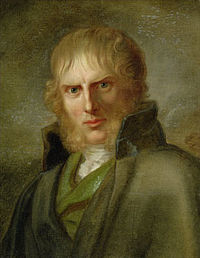|
Fontaine Art Studios
hand-painted reproductions on canvas
|
Direct Supplier with 179 Artists.
Stable Quality, Low Price, Fast Shipment.
|
|
Fontaine Art Studios
hand-painted reproductions on canvas
|
Direct Supplier with 179 Artists.
Stable Quality, Low Price, Fast Shipment.
|
 Caspar David FriedrichCaspar David Friedrich (September 5, 1774 – May 7, 1840) was a 19th-century German Romantic landscape painter, generally considered the most important of the movement.[2] He is best known for his mid-period allegorical landscapes which typically feature contemplative figures silhouetted against night skies, morning mists, barren trees or Gothic ruins. His primary interest as an artist was the contemplation of nature, and his often symbolic and anti-classical work seeks to convey a subjective, emotional response to the natural world. Friedrich's work characteristically sets the human element in diminished perspective amid expansive landscapes, reducing the figures to a scale that, according to the art historian Christopher John Murray, directs "the viewer's gaze towards their metaphysical dimension".[3]Friedrich was born in the Swedish Pomeranian town of Greifswald, where he began his studies in art as a youth. Later, he studied in Copenhagen until 1798, before settling in Dresden. He came of age during a period when, across Europe, a growing disillusionment with materialistic society was giving rise to a new appreciation of spirituality. This shift in ideals was often expressed through a reevaluation of the natural world, as artists such as Friedrich, J. M. W. Turner (1775–1851) and John Constable (1776-1837) sought to depict nature as a "divine creation, to be set against the artifice of human civilization".[4] Friedrich’s work brought him renown early in his career, and contemporaries such as the French sculptor David d'Angers (1788–1856) spoke of him as a man who had discovered "the tragedy of landscape".[5] Nevertheless, his work fell from favour during his later years, and he died in obscurity, and in the words of the art historian Philip Miller, "half mad".[6] As Germany moved towards modernisation in the late 19th century, a new sense of urgency characterised its art, and Friedrich’s contemplative depictions of stillness came to be seen as the products of a bygone age. The early 20th century brought a renewed appreciation of his work, beginning in 1906 with an exhibition of thirty-two of his paintings and sculptures in Berlin. By the 1920s his paintings had been discovered by the Expressionists, and in the 1930s and early 1940s Surrealists and Existentialists frequently drew ideas from his work. The rise of Nazism in the early 1930s again saw a resurgence in Friedrich's popularity, but this was followed by a sharp decline as his paintings were, by association with the Nazi movement, misinterpreted as having a nationalistic aspect.[7] It was not until the late 1970s that Friedrich regained his reputation as an icon of the German Romantic movement and a painter of international importance. |
Copyright © 2006-2024 paintingswholesaler.com, All Rights Reserved.
EMAIL: paintingswholesaler@gmail.com